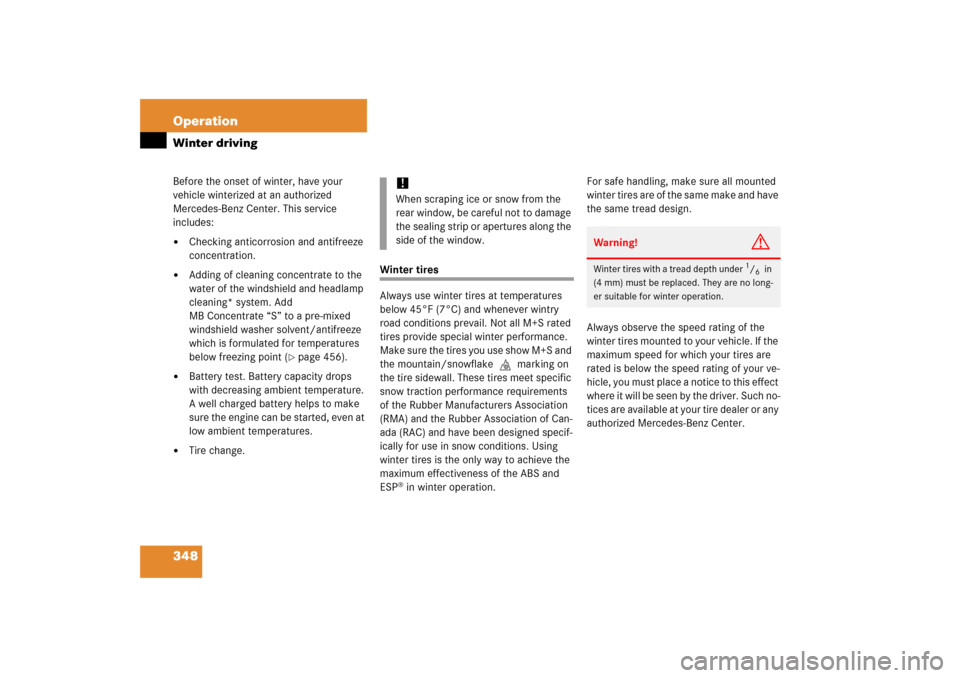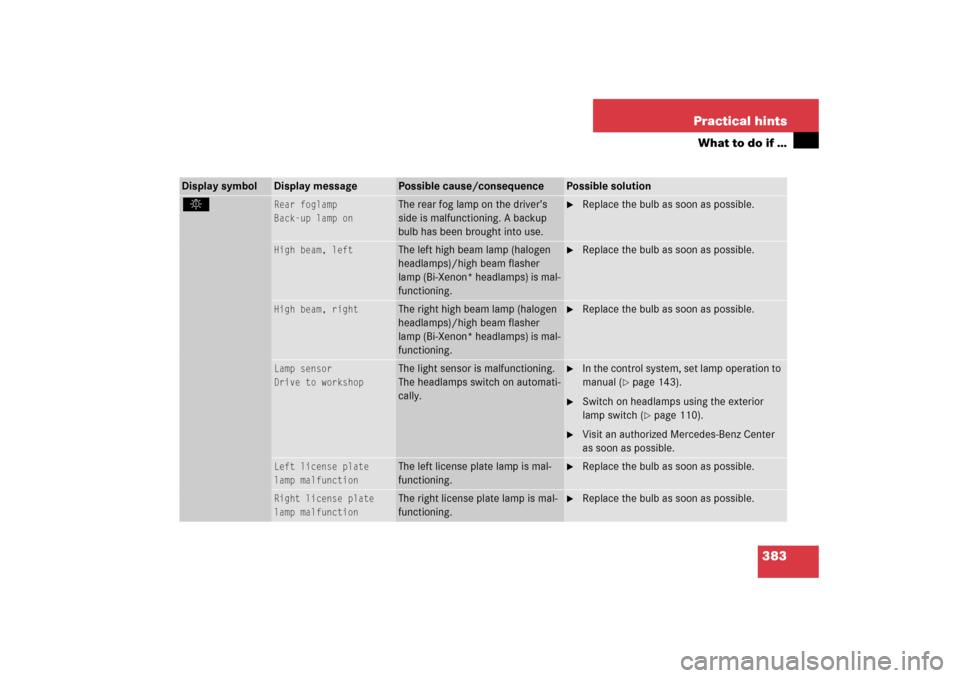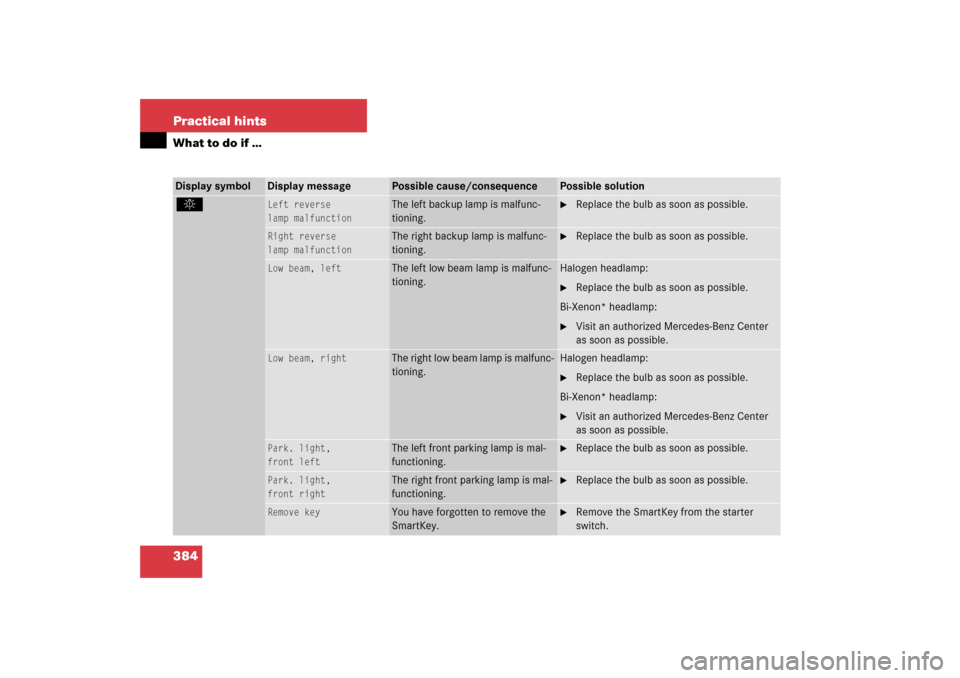Page 309 of 481

308 OperationEngine compartment
Closing�
Let the hood drop from a height of
approximately 1 ft (30 cm).
The hood will lock audibly.
�
Check to make sure the hood is fully
closed.
If you can raise the hood at a point
above the headlamps, then it is not
properly closed. Open it again and let it
drop with somewhat greater force.
Engine oil
The amount of oil your engine needs will
depend on a number of factors, including
driving style. Higher oil consumption can
occur when�
the vehicle is new
�
the vehicle is driven frequently at
higher engine speeds
Engine oil consumption checks should only
be made after the vehicle break-in period.
Warning!
G
If you see flames or smoke coming from the
engine compartment, or if the coolant tem-
perature display in the multifunction display
indicates that the engine is overheated, do
not open the hood. Move away from vehicle
and do not open the hood until the engine
has cooled down. If necessary, call the fire
department.Warning!
G
The engine is equipped with a transistorized
ignition system. Because of the high voltage
it is dangerous to touch any components
(ignition coils, spark plug sockets, diagnos-
tic socket) of the ignition system�
with the engine running
�
while starting the engine
�
if ignition is “on” and the engine is
turned manually
Warning!
G
Be careful that you do not close the hood on
anyone.
iDo not use any special lubricant addi-
tives, as these may damage the drive
assemblies. Using special additives not
approved by Mercedes-Benz may
cause damage not covered by the
Mercedes-Benz Limited Warranty.
More information on this subject is
available at any authorized
Mercedes-Benz Center.
��
Page 316 of 481

315 Operation
Engine compartment
Batteries contain materials that can harm
the environment if disposed of improperly.
Recycling of batteries is the preferred
method of disposal. Many states require
sellers of batteries to accept old batteries
for recycling.Windshield washer system and
headlamp cleaning system*
The windshield washer reservoir is located
on the passenger side of the engine com-
partment.SLK 350 (example)1Washer fluid reservoir cap
Fluid for the windshield washer system and
the headlamp cleaning system* is supplied
from the windshield washer reservoir. It
has a capacity of approx. 7.4 US qt (7 l).
G
Observe all safety instructions
and precautions when handling
automotive batteries.
A
Risk of explosion
D
Keep flames or sparks away
from battery. Do not smoke.
B
Battery acid is caustic. Do not
allow it to come into contact
with skin, eyes or clothing.
In case it does, immediately
flush affected area with clean
water and seek medical help if
necessary.
E
Wear eye protection.
C
Keep children away.
F
Follow the instructions in this
Operator's Manual.
Page 317 of 481

316 OperationEngine compartmentDuring all seasons, add MB Windshield
Washer Concentrate “S” to water. Premix
the windshield washer fluid in a suitable
container.
�
Pull cap upward using latch until it
opens.
�
Refill the reservoir with MB Windshield
Washer Concentrate and water (or
commercially available premixed wind-
shield washer solvent/antifreeze, de-
pending on ambient temperatures).
Always use washer solvent/antifreeze
where temperatures may fall below
freezing point. Failure to do so could re-
sult in damage to the washer sys-
tem/reservoir.
�
Push cap down until it engages.For more information, see “Windshield
washer system and headlamp cleaning
system*” (
�page 456).
Warning!
G
Washer solvent/antifreeze is highly flamma-
ble. Do not spill washer solvent/antifreeze
on hot engine parts, because it may ignite
and burn. You could be seriously burned.
!Only use washer fluid which is suitable
for plastic lenses. Improper washer flu-
id can damage the plastic lenses of the
headlamps.
Page 349 of 481

348 OperationWinter drivingBefore the onset of winter, have your
vehicle winterized at an authorized
Mercedes-Benz Center. This service
includes:�
Checking anticorrosion and antifreeze
concentration.
�
Adding of cleaning concentrate to the
water of the windshield and headlamp
cleaning* system. Add
MB Concentrate “S” to a pre-mixed
windshield washer solvent/antifreeze
which is formulated for temperatures
below freezing point (
�page 456).
�
Battery test. Battery capacity drops
with decreasing ambient temperature.
A well charged battery helps to make
sure the engine can be started, even at
low ambient temperatures.
�
Tire change.
Winter tires
Always use winter tires at temperatures
below 45°F (7°C) and whenever wintry
road conditions prevail. Not all M+S rated
tires provide special winter performance.
Make sure the tires you use show M+S and
the mountain/snowflake.marking on
the tire sidewall. These tires meet specific
snow traction performance requirements
of the Rubber Manufacturers Association
(RMA) and the Rubber Association of Can-
ada (RAC) and have been designed specif-
ically for use in snow conditions. Using
winter tires is the only way to achieve the
maximum effectiveness of the ABS and
ESP
® in winter operation.For safe handling, make sure all mounted
winter tires are of the same make and have
the same tread design.
Always observe the speed rating of the
winter tires mounted to your vehicle. If the
maximum speed for which your tires are
rated is below the speed rating of your ve-
hicle, you must place a notice to this effect
where it will be seen by the driver. Such no-
tices are available at your tire dealer or any
authorized Mercedes-Benz Center.!When scraping ice or snow from the
rear window, be careful not to damage
the sealing strip or apertures along the
side of the window.
Warning!
G
Winter tires with a tread depth under
1/6 in
(4 mm) must be replaced. They are no long-
er suitable for winter operation.
Page 358 of 481

357 Operation
Vehicle care
Headlamps, tail lamps, side makers,
turn signal lenses�
Use a mild car wash detergent, such as
Mercedes-Benz approved Car
Shampoo, with plenty of water.Cleaning the windows and the wiper
blades
�
Switch on the ignition (
�page 36).
�
Turn combination switch to wiper
settingII (
�page 56).
�
With wiper arms in vertical position,
switch off the ignition (
�page 36).
�
Fold the wiper arms forward until it
snaps into place.
�
Clean the wiper blade inserts with a
clean cloth and detergent solution.
�
Use a clean cloth and window cleaning
solution on all outside and inside glass
surfaces.
An automotive glass cleaner is recom-
mended.
!Only use window cleaners that are suit-
able for plastic lamp lenses. Window
cleaners which are not suitable may
damage the plastic lamp lenses of the
headlamps. Therefore, do not use abra-
sives, solvents or cleaners that contain
solvents.
Never apply strong force and use only a
soft, non-scratchy cloth when cleaning
the lenses. Do not attempt to wipe dirty
lenses with a dry cloth or sponge.
Otherwise you may scratch or damage
the lens surface.
!The windshield wipers must be in a ver-
tical position before folding them away
from the windshield. They could other-
wise damage the hood.
Never open the hood when the wiper
arms are folded forward.
Warning!
G
For safety reasons, switch off wipers and re-
move SmartKey from starter switch before
cleaning the windshield. Otherwise, the wip-
er motor could suddenly turn on and cause
injury.
��
Page 370 of 481
369 Practical hints
What to do if …
On the pages that follow, you will find
a compilation of the most important warn-
ing and malfunction messages that may
appear in the multifunction display.
For your convenience the messages are
divided into two sections:�
Text messages (
�page 370)
�
Symbol messages (
�page 374)
Warning!
G
No messages will be displayed if either the
instrument cluster or the multifunction dis-
play is inoperative.
Contact your nearest authorized
Mercedes-Benz Center.
iSwitching on ignition (
�page 36)
causes all instrument cluster lamps
(except high beam headlamp indicator
lamp and turn signal indicator lamps
unless activated) as well as the multi-
function display to come on. Make sure
the lamps and multifunction display are
in working order before starting your
journey.
Page 384 of 481

383 Practical hints
What to do if …
.
Rear foglamp
Back-up lamp on
The rear fog lamp on the driver’s
side is malfunctioning. A backup
bulb has been brought into use.
�
Replace the bulb as soon as possible.
High beam, left
The left high beam lamp (halogen
headlamps)/high beam flasher
lamp (Bi-Xenon* headlamps) is mal-
functioning.
�
Replace the bulb as soon as possible.
High beam, right
The right high beam lamp (halogen
headlamps)/high beam flasher
lamp (Bi-Xenon* headlamps) is mal-
functioning.
�
Replace the bulb as soon as possible.
Lamp sensor
Drive to workshop
The light sensor is malfunctioning.
The headlamps switch on automati-
cally.
�
In the control system, set lamp operation to
manual (
�page 143).
�
Switch on headlamps using the exterior
lamp switch (
�page 110).
�
Visit an authorized Mercedes-Benz Center
as soon as possible.
Left license plate
lamp malfunction
The left license plate lamp is mal-
functioning.
�
Replace the bulb as soon as possible.
Right license plate
lamp malfunction
The right license plate lamp is mal-
functioning.
�
Replace the bulb as soon as possible.
Display symbol
Display message
Possible cause/consequence
Possible solution
Page 385 of 481

384 Practical hintsWhat to do if ….
Left reverse
lamp malfunction
The left backup lamp is malfunc-
tioning.
�
Replace the bulb as soon as possible.
Right reverse
lamp malfunction
The right backup lamp is malfunc-
tioning.
�
Replace the bulb as soon as possible.
Low beam, left
The left low beam lamp is malfunc-
tioning.
Halogen headlamp:�
Replace the bulb as soon as possible.
Bi-Xenon* headlamp:
�
Visit an authorized Mercedes-Benz Center
as soon as possible.
Low beam, right
The right low beam lamp is malfunc-
tioning.
Halogen headlamp:�
Replace the bulb as soon as possible.
Bi-Xenon* headlamp:
�
Visit an authorized Mercedes-Benz Center
as soon as possible.
Park. light,
front left
The left front parking lamp is mal-
functioning.
�
Replace the bulb as soon as possible.
Park. light,
front right
The right front parking lamp is mal-
functioning.
�
Replace the bulb as soon as possible.
Remove key
You have forgotten to remove the
SmartKey.
�
Remove the SmartKey from the starter
switch.
Display symbol
Display message
Possible cause/consequence
Possible solution